Just NuGet the DotNetOpenAuth package. It will setup everything you need in your config file:

- Right click on the
References of your web project in the solution explorer
Add Library Package Reference...- Click on the
Online tab.
- In the search box type
dotnetopenauth
- Click
Install
Everything will be automatically setup and the correct assemblies will be downloaded from the internet and added as reference.
Here's how the web.config file looks like after performing this:
<?xml version="1.0" encoding="utf-8"?>
<!--
For more information on how to configure your ASP.NET application, please visit
http://go.microsoft.com/fwlink/?LinkId=152368
-->
<configuration>
<configSections>
<section name="uri" type="System.Configuration.UriSection, System, Version=2.0.0.0, Culture=neutral, PublicKeyToken=b77a5c561934e089" />
<section name="dotNetOpenAuth" type="DotNetOpenAuth.Configuration.DotNetOpenAuthSection" requirePermission="false" allowLocation="true" />
</configSections>
<connectionStrings>
<add name="ApplicationServices" connectionString="data source=.\SQLEXPRESS;Integrated Security=SSPI;AttachDBFilename=|DataDirectory|aspnetdb.mdf;User Instance=true" providerName="System.Data.SqlClient" />
</connectionStrings>
<appSettings>
<add key="ClientValidationEnabled" value="true" />
<add key="UnobtrusiveJavaScriptEnabled" value="true" />
</appSettings>
<system.web>
<compilation debug="true" targetFramework="4.0">
<assemblies>
<add assembly="System.Web.Abstractions, Version=4.0.0.0, Culture=neutral, PublicKeyToken=31BF3856AD364E35" />
<add assembly="System.Web.Helpers, Version=1.0.0.0, Culture=neutral, PublicKeyToken=31BF3856AD364E35" />
<add assembly="System.Web.Routing, Version=4.0.0.0, Culture=neutral, PublicKeyToken=31BF3856AD364E35" />
<add assembly="System.Web.Mvc, Version=3.0.0.0, Culture=neutral, PublicKeyToken=31BF3856AD364E35" />
<add assembly="System.Web.WebPages, Version=1.0.0.0, Culture=neutral, PublicKeyToken=31BF3856AD364E35" />
</assemblies>
</compilation>
<authentication mode="Forms">
<forms loginUrl="~/Account/LogOn" timeout="2880" />
</authentication>
<membership>
<providers>
<clear />
<add name="AspNetSqlMembershipProvider" type="System.Web.Security.SqlMembershipProvider" connectionStringName="ApplicationServices" enablePasswordRetrieval="false" enablePasswordReset="true" requiresQuestionAndAnswer="false" requiresUniqueEmail="false" maxInvalidPasswordAttempts="5" minRequiredPasswordLength="6" minRequiredNonalphanumericCharacters="0" passwordAttemptWindow="10" applicationName="/" />
</providers>
</membership>
<profile>
<providers>
<clear />
<add name="AspNetSqlProfileProvider" type="System.Web.Profile.SqlProfileProvider" connectionStringName="ApplicationServices" applicationName="/" />
</providers>
</profile>
<roleManager enabled="false">
<providers>
<clear />
<add name="AspNetSqlRoleProvider" type="System.Web.Security.SqlRoleProvider" connectionStringName="ApplicationServices" applicationName="/" />
<add name="AspNetWindowsTokenRoleProvider" type="System.Web.Security.WindowsTokenRoleProvider" applicationName="/" />
</providers>
</roleManager>
<pages>
<namespaces>
<add namespace="System.Web.Helpers" />
<add namespace="System.Web.Mvc" />
<add namespace="System.Web.Mvc.Ajax" />
<add namespace="System.Web.Mvc.Html" />
<add namespace="System.Web.Routing" />
<add namespace="System.Web.WebPages" />
</namespaces>
</pages>
</system.web>
<system.webServer>
<validation validateIntegratedModeConfiguration="false" />
<modules runAllManagedModulesForAllRequests="true" />
</system.webServer>
<runtime>
<assemblyBinding xmlns="urn:schemas-microsoft-com:asm.v1">
<dependentAssembly>
<assemblyIdentity name="System.Web.Mvc" publicKeyToken="31bf3856ad364e35" />
<bindingRedirect oldVersion="1.0.0.0-2.0.0.0" newVersion="3.0.0.0" />
<bindingRedirect oldVersion="1.0.0.0" newVersion="2.0.0.0" />
</dependentAssembly>
</assemblyBinding>
<legacyHMACWarning enabled="0" />
</runtime>
<uri>
<!-- The uri section is necessary to turn on .NET 3.5 support for IDN (international domain names),
which is necessary for OpenID urls with unicode characters in the domain/host name.
It is also required to put the Uri class into RFC 3986 escaping mode, which OpenID and OAuth require. -->
<idn enabled="All" />
<iriParsing enabled="true" />
</uri>
<system.net>
<defaultProxy enabled="true" />
<settings>
<!-- This setting causes .NET to check certificate revocation lists (CRL)
before trusting HTTPS certificates. But this setting tends to not
be allowed in shared hosting environments. -->
<!--<servicePointManager checkCertificateRevocationList="true"/>-->
</settings>
</system.net>
<dotNetOpenAuth>
<!-- This is an optional configuration section where aspects of dotnetopenauth can be customized. -->
<!-- For a complete set of configuration options see http://www.dotnetopenauth.net/developers/code-snippets/configuration-options/ -->
<openid>
<relyingParty>
<security requireSsl="false" />
<behaviors>
<!-- The following OPTIONAL behavior allows RPs to use SREG only, but be compatible
with OPs that use Attribute Exchange (in various formats). -->
<add type="DotNetOpenAuth.OpenId.Behaviors.AXFetchAsSregTransform, DotNetOpenAuth" />
</behaviors>
</relyingParty>
</openid>
<messaging>
<untrustedWebRequest>
<whitelistHosts>
<!-- Uncomment to enable communication with localhost (should generally not activate in production!) -->
<!--<add name="localhost" />-->
</whitelistHosts>
</untrustedWebRequest>
</messaging>
<!-- Allow DotNetOpenAuth to publish usage statistics to library authors to improve the library. -->
<reporting enabled="true" />
</dotNetOpenAuth>
</configuration>
UPDATE:
You could implement a custom resource retrieval provider:
public class CustomResourceProvider : IEmbeddedResourceRetrieval
{
public Uri GetWebResourceUrl(Type someTypeInResourceAssembly, string manifestResourceName)
{
return new Uri("http://www.google.com");
}
}
and then register it in web.config:
<dotNetOpenAuth>
<webResourceUrlProvider type="AppName.CustomResourceProvider, AppName" />
...
</dotNetOpenAuth>
But I would recommend you using the openid-selector library for generating login forms.
